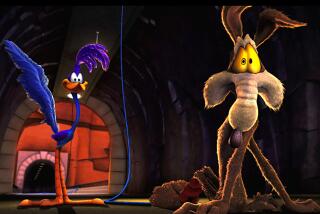Box-Office Fizzle of ‘Almost Famous’ Stirs Bad Blood
- Share via
‘Almost Famous” is a head scratcher.
Seeing Cameron Crowe’s entertaining ode to his days as a 1970s teen rock journalist, you’d think: Hit. And a profitable one because, with no stars, it certainly couldn’t have cost much.
Neither is turning out to be true.
One of the best-reviewed movies of the year, “Almost Famous” has failed to find an audience. Worse, the coming-of-age drama cost more than $60 million to produce.
After a month in release, the film has grossed $23 million and at this rate probably will top out at $35 million. It could, however, enjoy a renewed life if, as expected, it collects Oscar nominations when it’s re-released in December for Academy Award consideration.
This from the guy who made “Jerry Maguire.” That 1996 movie starring Tom Cruise won co-star Cuba Gooding Jr. a best supporting actor Oscar and was a mega box-office hit with around $275 million in worldwide receipts.
Crowe is understandably pained. So much so that the man who granted tons of interviews before his movie’s release refuses to come to the phone now to discuss it.
Relations between the writer-director-producer and DreamWorks SKG, which financed and released the movie, sources say, are strained. Crowe is questioning whether the studio, run by Steven Spielberg, Jeffrey Katzenberg and David Geffen, could have done, and spent, more to sell his movie.
Meanwhile, DreamWorks, which has been enormously supportive of Crowe and paid the overhead of his production company for three years before his deal expired this summer, is said to be deeply disappointed with the filmmaker. The movie went as much as $15 million over budget and a month over schedule.
DreamWorks marketing chief Terry Press said, “As far as we know, DreamWorks continues to have a great relationship with Cameron Crowe.”
Sources close to Crowe said that even before the movie opened, the DreamWorks partners were making snide remarks about how perturbed they were that their company had spent $60 million on “an art film,” “his little personal movie.” It gnaws at DreamWorks that Crowe’s next project, “Vanilla Sky,” is a big commercial love story starring Tom Cruise, Penelope Cruz and Cameron Diaz for Paramount Pictures.
Divining where the money was spent on “Almost Famous” isn’t easy.
The film’s male lead, Patrick Fugit, is an unknown 16-year-old actor from Utah. And his love interest, Kate Hudson, Goldie Hawn’s 21-year-old daughter, is a relative newcomer, though her career is sure to take off based on her widely noticed performance.
Crowe accounted for the biggest “above-the-line” talent expense, getting $7 million to write, direct and produce. The bulk of the movie’s costs were spent on the production itself.
Crowe shoots reams of film and takes his time doing it. He pays excruciatingly close attention to every detail--obsessively re-creating an exact replica of the old San Francisco offices of Rolling Stone and meticulously costuming hundreds of extras in a crowd scene who were never shown in close-ups.
Crowe’s “Almost Famous” script was 172 pages, compared with the screenplay average of 119. The production ran 92 days, whereas the average number of shooting days is 50 to 65 days.
Having a 16-year-old actor in every scene who, as a minor, could work only limited number of hours a day, also slowed down production.
In an article he wrote for the October issue of Rolling Stone, Crowe recounted what Spielberg told him when he first read his untitled script: “Shoot every word.” Taking him literally, Crowe admits, “I did many takes. . . . I shot scenes from many angles. I worked on every detail, large and small. . . . I didn’t quite shoot every word. We came close.”
For instance, Crowe shot and re-shot the film’s live concert scenes with the actors performing original songs by the faux rock group Stillwater until it looked right.
According to one of Hollywood’s top music executives, Kathy Nelson, who heads music for Disney’s live-action movies, that can add a lot to a music budget.
Featuring 50 songs by major artists, the “Almost Famous” music budget was a whopping $3.5 million. Typically, a major film’s music budget is less than $1.5 million.
DreamWorks’ executives suspected early on that all that effort and money had bought them a “small” movie. In a sign of last-minute nerves only weeks before the movie opened, DreamWorks brought in a partner to help minimize its financial exposure, selling its international rights and to two other upcoming productions to Sony Pictures.
Sony, the studio that made “Jerry Maguire,” wrote a $100-million check for the package, which also includes a big-budget Ivan Reitman special-effects comedy, “Evolution,” which begins shooting this month, and a low-budget Barry Levinson comedy, “An Everlasting Piece,” which is in post-production.
Sony will split the “Almost Famous” revenue 50-50 with DreamWorks. On the other two films, the studio just retains foreign receipts, with DreamWorks keeping the domestic take.
Sony Pictures Chairman John Calley defended the hefty price tag. “I think it was a good buy and we’re well invested in it,” he said, noting the likelihood of Oscar nominations will bolster the overseas box office.
Sources said Sony is allocating $35 million to “Almost Famous,” $55 million to “Evolution” and the remainder to “Everlasting Piece.” One source said Katzenberg, who negotiated the deal, wanted to make sure to cover 60% of the negative costs of each of the three films, which the $100-million acquisition price does.
There are various theories as to why the film so far has missed its mark.
One theory is that DreamWorks struggled with how to market the R-rated movie and failed to give it the kind of advertising support it needed, especially on television.
Marketing certainly plays a key role, but it’s never the sole reason that a film either flops or hits.
Because “Almost Famous” had no major stars to automatically pull in audiences, it’s precisely the kind of movie that depends heavily on strong reviews and word of mouth.
Consequently, DreamWorks held 425 word-of-mouth screenings across the country and “platformed” the film’s release, rolling it out slowly in hope of building an audience. The film’s early showings in limited markets looked very promising.
But when the run was expanded to 1,200 screens, the movie failed to replicate in small markets the success it was having in big cities such as Los Angeles and New York, a problem that was foreshadowed in early test screenings.
The consensus among studio executives, producers and other industry observers interviewed is that “Almost Famous” failed to be a commercial hit because it was betwixt and between.
A movie set in the ‘70s about a music reporter’s behind-the-scenes involvement with a fictitious rock band named Stillwater, it didn’t appeal to moviegoers younger than 30--the most sought-after audience--and it didn’t strike a chord with the over-50 crowd. The era and its music have little, if any, emotional relevance to either moviegoing sector.
“It fit into too small a demographic,” observed one producer, referring to those who came of age in the late 1960s and 1970s and grew up on the music of Led Zeppelin, Black Sabbath, the Allman Brothers, Deep Purple and Stevie Wonder.
In his current Rolling Stone article, Crowe said he had “learned more than ever about the privilege of being given a huge canvas on which to paint a film, a love letter to music.”
He obviously spared no expense, and DreamWorks is not happy to be paying the price.
More to Read
The biggest entertainment stories
Get our big stories about Hollywood, film, television, music, arts, culture and more right in your inbox as soon as they publish.
You may occasionally receive promotional content from the Los Angeles Times.










